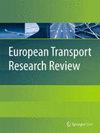Route choice modelling for an urban rail transit network: past, recent progress and future prospects
IF 4.2
3区 工程技术
Q1 TRANSPORTATION
引用次数: 0
Abstract
Route choice modelling is a critical aspect of analysing urban rail transit (URT) networks and provides a foundation for URT planning and operation. Unlike in a free-flow road network, the consideration set for route choice decisions in a URT network does not depend purely on the physical connectivity of the network and decision makers’characteristics. Instead, it is also contingent on the train schedules. This paper delves into the evolution of research on route choices in URT networks, encompassing both probabilistic route choice modelling derived from utility maximisation theory and logit curve with physical connectivity, and retrospective route choice modelling based on travel time chaining along with comprehensive transport data. The former is noted for its conciseness, simplicity, and interpretability in real-world applications, even though the methodologies may not be cutting-edge. The latter incorporates dynamic temporal information to understand activities of passengers in URT networks. Enhancements of each genres are also examined. However, these improvements might not fully address the inherent limitations of models relating to a dependency on the quality of parameters, experience of experts, and calculation efficiency. In addition, novel research adopting contemporary data mining techniques instead of classical models are introduced. The historical development of research on URT network route choices underscores the importance of amalgamating independent information networks such as surveillance networks and social networks to establish a comprehensive multi-dimensional network. Such an approach integrates passenger attributes across networks, offering a multi-dimensional understanding of passengers’ route choice behaviours. Our review work aims to present not only a systematic conceptual framework for route choices in URT networks but also a novel path for transport researchers and practitioners to decipher the travel behaviours of passengers.城市轨道交通网络的线路选择建模:过去、近期进展和未来展望
路线选择建模是分析城市轨道交通(URT)网络的一个重要方面,也是城市轨道交通规划和运营的基础。与自由流动的道路网络不同,城市轨道交通网络中路线选择决策的考虑集并不完全取决于网络的物理连接性和决策者的特征。相反,它还取决于列车时刻表。本文深入探讨了城市轨道交通网络中线路选择研究的发展历程,包括从效用最大化理论和具有物理连通性的对数曲线中得出的概率线路选择模型,以及基于旅行时间链和综合交通数据的回顾性线路选择模型。前者因其简洁、简单和在实际应用中的可解释性而备受关注,尽管其方法可能并不先进。后者结合了动态时间信息,以了解 URT 网络中乘客的活动。此外,还对每种流派的改进进行了研究。不过,这些改进可能无法完全解决模型的固有局限性,这些局限性与参数质量、专家经验和计算效率有关。此外,还介绍了采用当代数据挖掘技术代替经典模型的新研究。城市轨道交通网络路线选择研究的历史发展强调了将独立的信息网络(如监控网络和社交网络)整合起来以建立一个全面的多维网络的重要性。这种方法整合了各网络的乘客属性,提供了对乘客路线选择行为的多维理解。我们的综述工作不仅旨在为城市轨道交通网络中的线路选择提供一个系统的概念框架,还为交通研究人员和从业人员解读乘客的出行行为提供了一条新途径。
本文章由计算机程序翻译,如有差异,请以英文原文为准。
求助全文
约1分钟内获得全文
求助全文
来源期刊

European Transport Research Review
Engineering-Mechanical Engineering
CiteScore
8.60
自引率
4.70%
发文量
49
审稿时长
13 weeks
期刊介绍:
European Transport Research Review (ETRR) is a peer-reviewed open access journal publishing original high-quality scholarly research and developments in areas related to transportation science, technologies, policy and practice. Established in 2008 by the European Conference of Transport Research Institutes (ECTRI), the Journal provides researchers and practitioners around the world with an authoritative forum for the dissemination and critical discussion of new ideas and methodologies that originate in, or are of special interest to, the European transport research community. The journal is unique in its field, as it covers all modes of transport and addresses both the engineering and the social science perspective, offering a truly multidisciplinary platform for researchers, practitioners, engineers and policymakers. ETRR is aimed at a readership including researchers, practitioners in the design and operation of transportation systems, and policymakers at the international, national, regional and local levels.
 求助内容:
求助内容: 应助结果提醒方式:
应助结果提醒方式:


